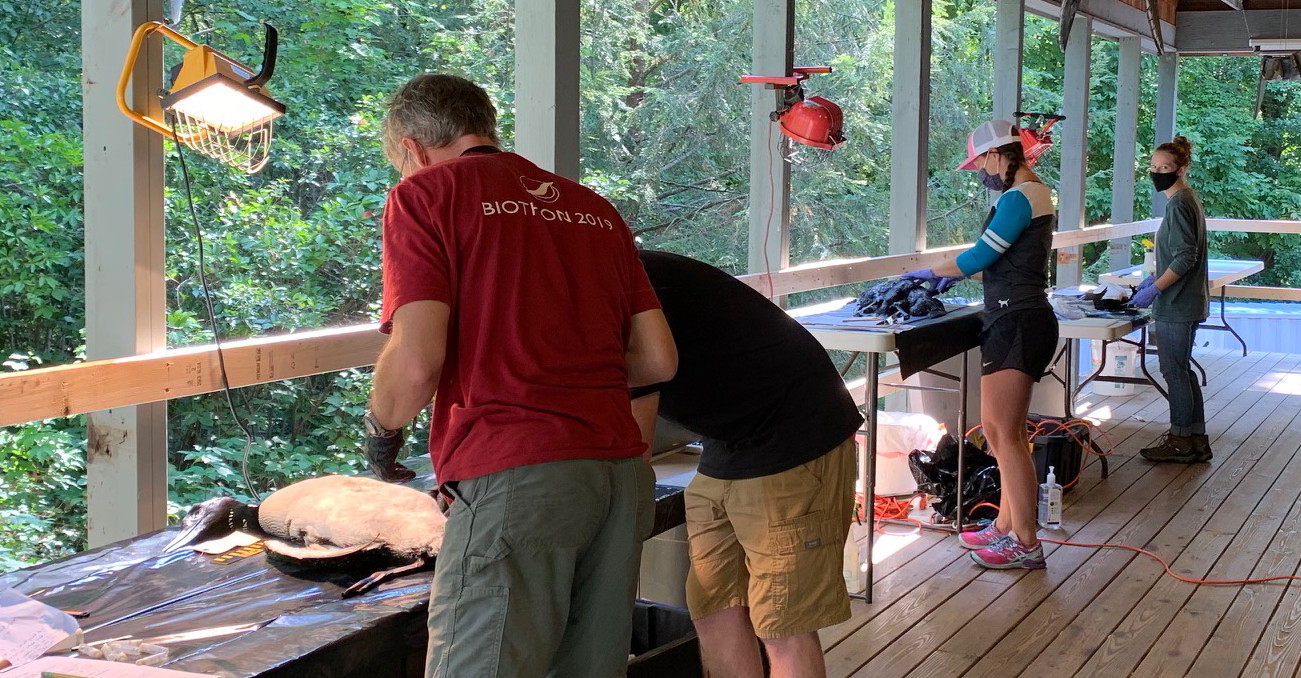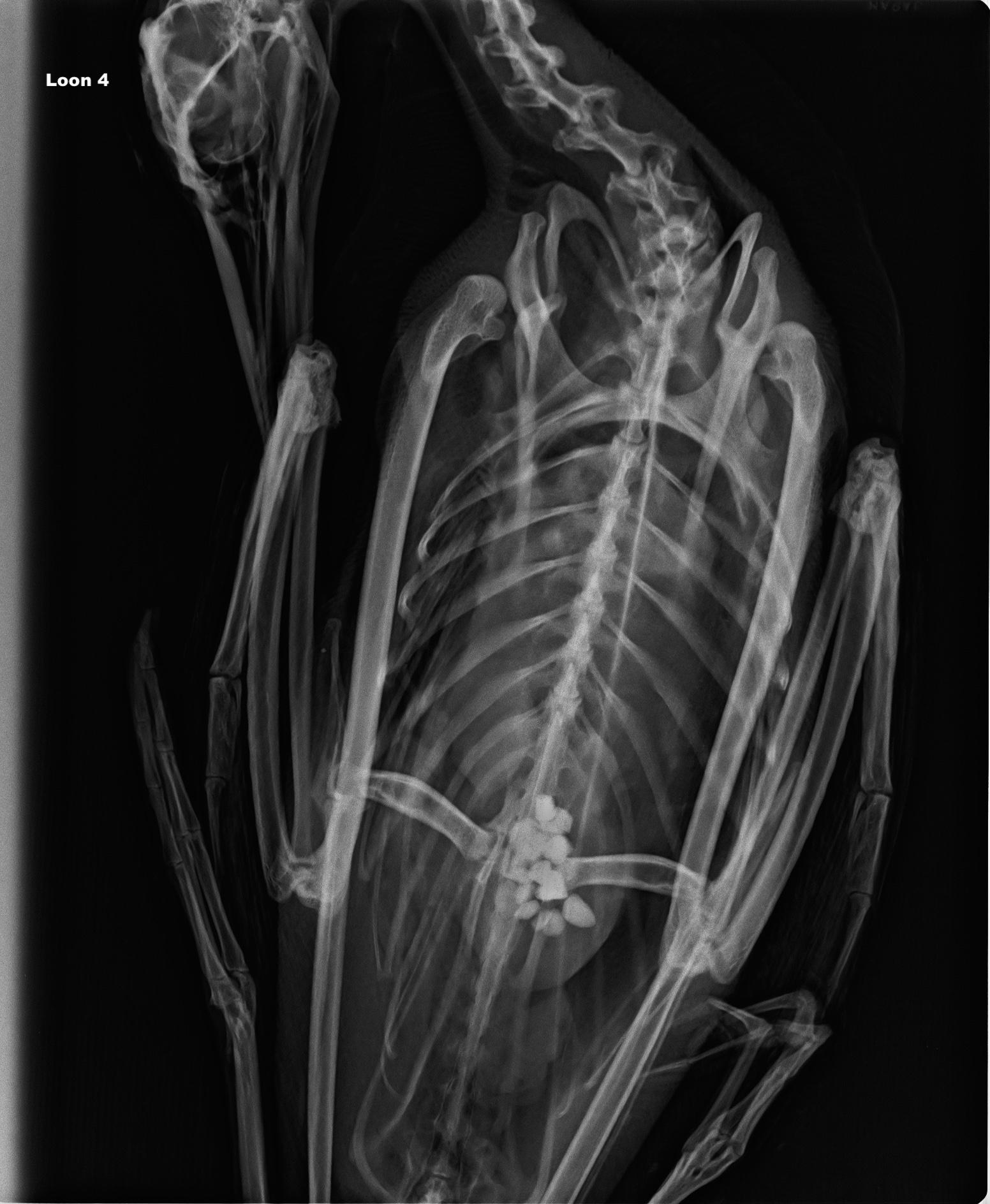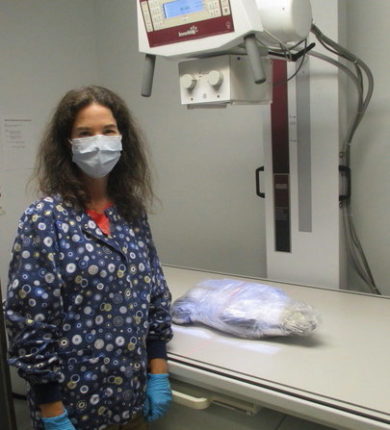
Exam room on the porch of the Loon Preservation Committee headquarters in NH. From L to R, Eric Hanson (VCE), Brent Lundborg (VINS), Dr. Sarah Spindell (Bridgeton Vet Hospital), and LPC seasonal biologist, Elaina Badders. © Caroline Hughes.
Every summer, the Vermont Loon Conservation Project (VLCP) attempts to physically collect all reported dead loons so that we can try to figure out what happened to each and every one. (See this summer’s Loon Caller for a summary of Vermont’s mortality records over the past 30 years: Loon Caller 2020). In the past, we’ve frozen most of the birds and sent them for necropsies to Tufts University School of Veterinary Medicine Wildlife Medicine Program Loon Health and Mortality project where Dr. Mark Pokras has led the charge in understanding the reasons loons die. Common causes of loon death include: lead sinkers, monofilament fishing line, loon fights, boat hits, sibling rivalry between chicks, lung fungal disease, pneumonia, high parasite loads, malaria, crash landings, and more. Now, VLCP personnel are going to perform necropsies ourselves–which is why I signed up for a crash course on loon anatomy with the Loon Preservation Committee (LPC) in New Hampshire earlier this summer.
Why the change? During the mortality session at our annual two-day regional loon meeting (Northeast Loon Study Work Group – NELSWG), veterinarians, pathologists, water quality scientists, and wildlife researchers identified a need for the collection of more fresh tissue and blood samples instead of frozen ones. Fresh samples allow researchers to conduct a wider array of tests, especially for parasites and malaria. However, the logistical hurdles of delivering fresh loons within 24 hours of finding them to the Tufts Wildlife Clinic in Massachusetts or the University of New Hampshire (UNH) pathology lab (where a former student of Dr. Pokras, Inga Sidor, has expanded our ability to examine loons) are high, not to mention time-consuming, expensive, and incredibly inconvenient. So, what if field biologists carried out the examinations? All we’d need is a way to keep the deceased birds cool until we could examine them, and it would be an excellent way to expand our knowledge of what’s happening to our loons. We’re going to give this new system a try and see how it goes. The other reason for doing necropsies closer to home this year is that the Tufts vet lab is closed for extra projects like loon necropsies due to COVID-19. I’m sure we’ll miss some things that experienced doctors Pokras or Sidor would catch, e.g., slight discoloration of the liver, enlarged pancreas, etc. But, we’ll take lots of photos to send to the experts.
During my first try at a necropsy, I worked alongside John Cooley and Caroline Hughes of the LPC, and Bren Lundborg from the Vermont Institute of Natural Science (VINS) Center for Wild Bird Rehabilitation drove over to join us. Bren will be a great asset here in Vermont, as he already has some experience in this work and is excited to help out. Dr. Pokras chimed in virtually via Zoom to view some cases and answer questions. We performed three loon necropsies in the morning and another four in the afternoon. Bren and I will do the remaining three birds from Vermont in November at VINS when their wildlife rehab work slows down.

Radiograph of a loon from Long Pond (Westmore). Note the round white objects in the gizzard; these are stones for aiding digestion–a bird’s teeth. © Hardwick Veterinary Clinic.
Here are a few of the outcomes from our “necropsy day” at LCP headquarters:
The first loon was from Long Pond in Westmore. It had been beaching itself, but was not part of the pond’s territorial pair raising two chicks. We had brought it to a smaller pond for observation, where it ultimately died. This loon had an obvious hole in the sternum from an attack by another loon. However, there was no underlying observable damage. The wound could have been from months or even years ago–thus Pokras didn’t think that a loon fight was the immediate cause of death. We found a bunch of parasites (tapeworms) as well. A weakened loon becomes more susceptible to things like parasites and fungal disease, but neither caused this loon’s death–so at this point, the cause remains unknown.
A loon from Long Pond in Eden/Belvidere was found dead floating in the water in early September. We discovered that this one died from a lung fungal disease, aspergillosis. Air sacs in the lungs that are usually made of a thin membrane were thickened to the point of looking like major muscle.
I examined an eight-week old chick from Wolcott Pond. At first we thought there was fishing gear present as we spotted a metal wire object in the x-ray. It turns out that this was the twist-tie from the bag the bird was in! Lesson learned. The bird was half the weight it should have been at eight weeks; it was starving. But what caused this predicament? The gizzard was full of short strands of a material that had vegetation qualities, but we could not tell for certain what it was. Folks at Tufts or UNH will assess the photos and samples we took at a later date, which will hopefully shed more light on this chick’s mysterious death.
The estimated annual mortality rate for adult loons is around 5%. Much of this likely occurs during the winter and migration, which can be stressful times (imagine staying warm and making a living on Cape Cod in January). Our work in the summer months can hopefully guide where research needs to go to reduce human-caused sources of mortality. For example, lung fungal disease cases have increased over the past decade–what might be contributing to this natural disease that tends to hit immune-compromised birds? A healthy loon will keep the fungus in check. Is it stress from competition and more loons or is it changes in water quality and potentially climate change? Could this affect other wildlife and even people? We’ll keep searching for answers as best we can.

Denise O’Connor and the x-ray machine at the Hardwick Veterinary Clinic. Photo by Eric Hanson
Thanks to Andrea Gilbert and Denise O’Connor at the Hardwick Veterinary Clinic for taking radiographs of six loons (and they’ve taken care of my cats for years). Thanks also to John Cooley and Caroline Hughes at LPC for hosting and sharing their knowledge, Dr. Mark Pokras for guiding us along, and Bren Lundborg and VINS for taking on a major role in this work for Vermont. I would be remiss if I did not thank the lake residents, volunteers, and game wardens who help care for and retrieve loons in distress. It’s not easy see something you love not make it, let alone have to handle and deliver its body for further study. Lorna and Brent Kane-Rohloff, Sheila Goss, Gail Osherenko, Jan Roy, and VCE’s Susan Hindinger all assisted with the birds in this story.

Thank you for this information…we appreciate the work , time, and effort involved in taking on the task of necropsies.